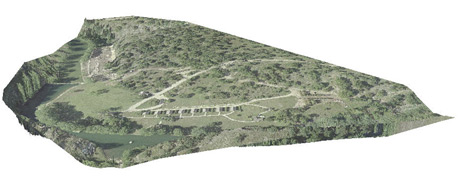I had a meeting last week with a potential client who specializes in GIS development. Before I got into 3D imaging I spent a lot of time as a GPS/RTK surveyor collecting assets and building GIS databases for clients. During last week’s meeting it hit me that it had been awhile since I had even thought about GIS (other than skimming ArcUser when it hits my mailbox). I still have friends that are very deep in the GIS world but they don’t seem to have any professional interest in 3D imaging, and tell me that there does not seem to be anything coming down the ESRI pipeline that will incorporate the type of 3D imaging that we do any time soon.
I will admit that integrating point cloud data into GIS was one of the first things I tried to do when I got a scanner. I had the idea that I was going to open the eyes of my GIS customers. They were accustomed to drilling down until you got to a specific site in their databases. That site was typically crude line work that was “accurately” placed on aerial photography. If they were really advanced they might have building footprints as well. I was going to give them the ability to dive into that site in all of its 3D glory! In fact, I even showed examples using hyperlinks and ESRI’s 3D analyst at Leica’s Worldwide User Conference in 2006. After that it pretty much stalled out. I tried again when TruView was released as the “free to the end user” aspect seemed like a good selling point. Alas, the interest was nonexistent.
That year I attended the DistibuTECH conference with an eye toward tying the electrical system operator’s GIS into data that could be used by their engineering departments. I attended the GIS track and quickly learned that to this industry (electricity distributors) GIS still meant single points, meter accuracy, and maybe some snapshots. I was trying to sell a fighter jet to guys using a horse and buggy. That’s what happens when you start to believe IBM smart grid commercials instead of reading white papers.
After that, I turned my focus away from GIS with a single exception being the mobile LiDAR platforms for fast asset inventory collection. All of this is to say that I still do not completely understand why GIS operators have not been screaming for 3D imaging data. But I do have some ideas. Unlike Bentley or Autodesk, ESRI does not have other product lines that lend themselves to point cloud data so there is less incentive for the manufacturer to develop additional 3D tools. Many (if not most) of the users are government employees. Not much incentive there for change either! Lastly, the real power of GIS is not the mapping but the databasing and querying. 3D imaging does not help with that at all.
So, does that mean that GIS will forever be separated from high definition mapping? I still have hope that they will be integrated. BIM is essentially a model based GIS. It would seem that the tools for one would be transferable to the other. However, until someone finds a way to run database queries from 3D data, I’m not holding my breath.
Point of Parliamentary Procedure: It turns out that the comments section was disabled on my blog! For those of you that made comments, they were sent to me but they were not displayed (as they should have been) below the blog post to which they referred. I apologize for not noticing this sooner. This has now been corrected so feel free to opine away! I would love to hear your opinions, experiences or whatever you may have that would add to our understanding of the topic at hand.






